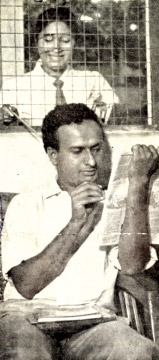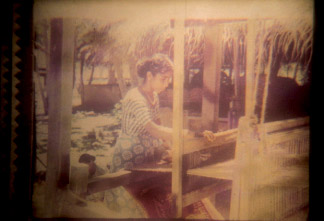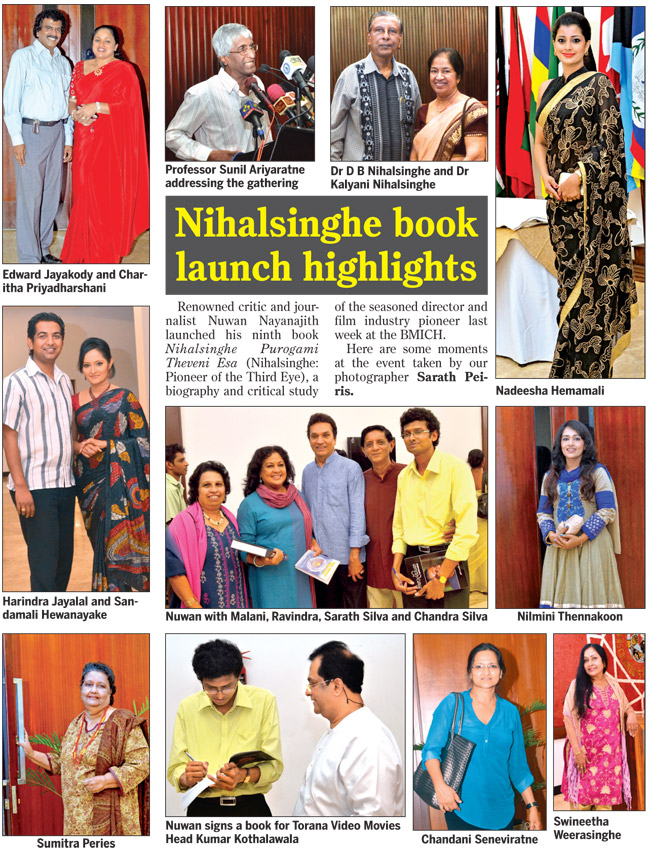|

Of Dhammi after Sugath
Channa Bandara Wijekoon
When Karunasena Jayalath wrote the lyrics of the song, Aadarei Mama
Aaderei…Dhammi Thawamath Aadarei (sung by Sisira Senarathne and Indrani
Wijebandara), there had been no plans to make the film Golu Hadawatha.
|

Anula as Dhammi with Wickrama Bogoda as Sugath in Golu Hadawatha |
Jayalath wrote the lyrics to be in line with the same theme of his
novel, Golu Hadawatha .
Sugath (Wickrama Bogoda) and Karunasena Jayalath are no more. Anula
Karunatilleke who induced life to Jayalath’s ‘Dhammi’ in Dr Lester
Peries’s masterpiece Golu Hadawatha , now lives a quiet life away from
the entire hassle dazzle in the metro.
It seems like Dhammi’s charming and tender smile has chosen to stay
with Anula, for a lifetime. A faint image of a brimming and youthful
Dhammi appears before us. The one who gave life to the most quixotic
lover in the recent history of Sinhala cinema is now ready to go down
the memory lane and recall incidents which took place 46 years back,
associated with Golu Hadawatha .
Song and film
The song Aadarei Mama Aaderei…Dhammi Thawamath Aadarei was
broadcasted over radio frequently before the film was released. It
became very popular among the listeners as a very romantic song.
“Jayalath had requested Dr Peries to include it in the film, although
the latter had been reluctant to include a song in his film," Anula
recalls with a smile.
“When the film was being shot, there was a New Year celebration in
Jayalath's home town. We witnessed Sisira and Indrani singing this song
at this venue,” she says.
Jayalath had first seen Anula at the Lumbini theatre. His cousin
sister had shown Anula to him and said, 'Look aiya, your Dhammi is right
in front of us.' I was 18 then. Jayalath did not speak to me on that
day,”says Anula.
Dr Peries had been doing Delowak Athara at the time and Anula was
casted in the film. Eventually on realizing Anula’s tender looks does
not go with the character, Peries had come to Anula’s residence to tell
her that the character in the film will be given to Suvineetha Kongahage.
|

Anula Karunatilleke. Picture by Ranjith Asanka |
Lester had also hinted that he is reading a book during that time
although he had told Anula to keep the advance payment for her character
in Delowak Athara .
Recasting Anula’s character in Delowak Athara had raised a hornet’s
nest in the circles. Daya Ranaweera the seasoned photo-journalist who
was Anula’s husband, had been under severe pressure.
Then Peries had broken the news that Anula had been chosen for the
main character in his next film Golu Hadawatha . Many auditions had
taken place by that time to select actors for the two characters, Sugath
and Dhammi. Sudesh Guneratne, Vijaya Kumaratunga and Buddhadasa
Withanarachchi, had been some of the actors who had come for the
auditions.
“Amid all the controversy, Wickrama Bogoda became Dr Peries’s Sugath
and I became his Dhammi,” says Anula. Shooting began in 1967. Anula was
21 then. Wickrama Bogoda had been an actor groomed from Sugathapala
Silva’s stage drama clan Apae Kattiya . He had been very popular in the
drama sphere at the time and had acted in dramas such as Boarding
Kaarayo, Thattu Gewal and Ran Thodu .
In 1962, Anula had acted in Dr Peries’ Gam Peraliya . In 1963 she had
become the best stage drama actress at the State drama festival for her
performance in Ran Thodu while Tony Ranasinghe became the best actor.
Golu Hadawatha shooting
Most of the shooting had been done in Pannipitiya Dharmapala College.
Some of Anula’s fans had written to her saying that they hated her for
the character she played in the film.
In the film, Dhammi a somewhat mischievous girl, drags Sugath into a
love affair and eventually dumps him due to unavoidable circumstances.
Sugath becomes a loner, a man without love.
Premasiri Khemadasa’s music provided much boost for the characters
played by Anula and Bogoda. The very first comment for Anula’s acting in
the film had come from Khemadasa. He had come to her and said, “Anula, I
lost control of myself by looking at you playing the character of Dhammi.
This film will take you to unexpected heights.” “I had a very cordial
relationship with Jayalath more than with Dr Peries and Bogoda while
doing the film. I even told Jayalath that filmgoers will hate me for
this character. Then he told me, 'You wait and see Anula. People are
going to love you forever when the film is released’," recalls Anula.
“What Jayalath told that day, has now become a reality. When my
telephone number appeared in a film magazine very recently, telephone
calls were pouring in. My fans from all over the world were calling me.
They told me when the film was released many decades back that they were
not able to meet me or contact me. What they said was true. Those days
we used to get bundles of letters from our fans and that was the only
communication between us. They could have a glimpse of us only at a film
festival,” she notes.
Memories of Bogoda
According to Anula acting is a meditation. One should ‘live’ in the
character to give life and add credibility to the character. She says,
Wickrama Bogoda is such an actor. She strongly feels, they both have
given their maximum to the roles.
“Even if I become young again, I will not be able to perform that
character so well," she revealed.
“Wickrama and I used to byheart our dialogues and Dr Peries gave us a
free hand to perform the characters. He used to watch me very closely
when I interacted with friends and other people outside the sets. He
subtly gets those gestures of mine to the celluloid when shooting
begins. One such thing was playing Athuru Mithuru in the class room.
Jayalath was always near me and like a little child, he got close to us.
A real experience in life had swayed Jayalath to write ‘Golu Hadawatha’.
He shared those experiences with me to induce in me the real temperament
of Dhammi”, says Anula.
Bogoda too was a seeker of true love. He was a real gentleman and a
very sensitive person. I admitted to him once that if I met Sugath in
real life, I would have definitely run away with him but if you were
Sugath, I would never marry you,” she revealed with a mischievous
twinkle in her eye. Bogoda had loved people although he didn’t love
himself. In the latter stage of his life, he had distanced himself from
the society.
Time is barrier
Anula came to the fore once again after a long lapse, in the tele-drama
Amba Yahaluwo . She has completed 50 years in the sphere and now prefers
to live a quiet life.
Her late husband Daya Ranaweera is remembered by Anula with deep
gratitude. Her second son Binara is looking after the mother at their
ancestral home in Matara. “The music in some scenes of Golu Hadawatha
still echo in my mind. Sometimes I still dream of my school days,”says
Anula.
Yes, ‘time’ is a relative factor as Einstein said. Also, time is no
barrier for an artiste who had carved a niche in the minds of people.
The emotional interaction between such artistes and their fans break all
barriers.
Golu Hadawatha, the novel and the film brought the basic feelings of
lovers to the fore. These true emotions will not fade away with time.
They will stay with sensitive people forever.
[email protected]
Documentaries are forever
Ishara JAYAWARDANE
Professor Ariyarathna Athugala and Ashley Ratnavibhushana recently
joined hands to convene a press conference on the burning issue of the
future of documentaries in Sri Lanka.
“There is a need to revive the Fine Arts scene in this country. There
is need for an intervention. The Government Information Department has
its roots in the Government Film Unit (GFU). The documentary and feature
films have its foundation there. We feel that the GFU is responsible for
strengthening the film fraternity and its duty is to make the world
aware of Sri Lankan Cinema. Documentary films have played a vital role
throughout the world creating awareness of various cultures and
societies. Reality shows and the Discovery Channel has been generated by
this type of film. These documentaries and short films have a special
significance to the youth. Exposure to documentaries and short films is
important before engaging in big film productions,” said Professor
Athugala.
|

A scene from one of the documentaries |
With the emergence of Sri Lanka (then Ceylon) as a fully independent
democratic State in 1948, the existence of a well informed, enlightened
public opinion became a vital necessity. It became essential for the
government to keep the masses informed of the development schemes that
had been launched and also to instruct and educate the people on various
aspects of life in a democratic state. The need for an organization to
achieve this goal was soon realized and the GFU was set up in September,
1948 in response to this need.
“During this period two Italians were here with the aim of working in
a Sinhalese film. When they arrived here the film production company was
closed and finally the government came to know about these two persons
and assigned them to set up the GFU since we didn’t have technical
personnel necessitated. Initially it was a small unit, and it was housed
in a room let by the Department of Irrigation in Jawatte Road, Colombo.
Two Italians: Gulio Petroni and Federico Serra, functioned as film
director and technician. They rendered an indelible service to Sri
Lanka. The first newsreel they shot was the First Anniversary of the
Independence Celebrations held in February 4, 1949,” said
Ratnavibhushana
During Petroni’s stay of about three years, he made several short
news films and two documentaries: Hill Capital and New Horizons . Hill
Capital (24 mts) was a documentary film on the picturesque and
historical city of Kandy. New Horizons (45 mts) dealt with the land
reclamation and colonization schemes of the government. These two
documentary films influenced several local filmmakers to join GFU. By
the middle of 1949, the GFU was fairly well established in its new
premises - an ex-British Armed Services cinema, situated in a large
coconut estate called “Velona Estate” in Moratuwa.
Later Italian technician George Calabria, British editor George Sturt,
British documentary filmmaker Ralph Keene, Spanish cinematographer Bob
Navaro joined GFU. Like Gulio Petroni and Federico Serra they too
rendered a great service to Sri Lanka. From the Sri Lankan side George
Wickramasinghe, Pragnasoma Hettiarachchi, Erwin Dasanayake, Abeykoon
Seneviratne, Lester James Peries joined GFU as directors.
The renowned German director Paul Zils joined the GFU during 1968-69.
In 1970s D.B. Nihalsinghe, Tissa Abeysekara, Tissa Liyanasooriya, Ranjit
Lal, Sugatapala Senarath Yapa also joined GFU and made several
documentary and news films. The films produced by GFU have won numerous
awards at prestigious international film festivals such as Venice,
Berlin, Leipzig, Salerno and Karlovy Vary.
“The festival of outstanding documentary and news reels produced by
GFU is scheduled to be held at the new auditorium of the Department of
Information from February 20 to 23. Screenings commence at 4 pm. It
provides a unique opportunity to the public to seen these documentary
and news films produced by GFU in the early period,” said
Ratnavibhushana
A Sinhala book published by the GFU titled Pratibehedekma
(Reminiscences) covering the complete history of the GFU will be
launched at the inauguration of the festival.
The Festival of Classic Documentaries and Newsreels produced by the
GFU will be opened by Mass Media and Information Minister Keheliya
Rambukwella.
 |







